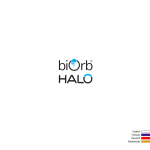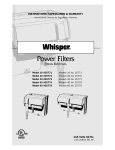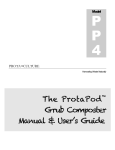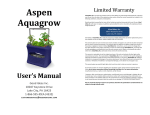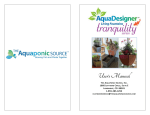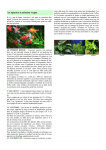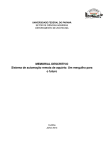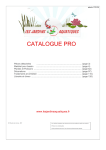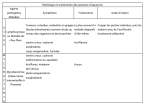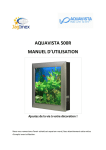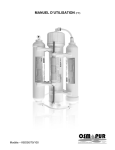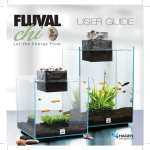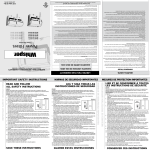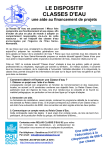Download - Federation of British Aquatic Societies
Transcript
EDITORIAL CONSERVATION HENDERSON’S A HIT ASK US – WHAT THE ‘L’? GREEN CORNER – FLUVAL CO2 BOOK REVIEW – LOACHES – Balitorid Family KEVIN’S KAPERS ECHINODORUS: AMAZON SWORDPLANTS Pt 2 NATURAL BREEDING KNOW YOUR FISH – Panaque nigrolineatus FOOD – AND WATER QUALITY TINY TANK LATOUR-MARLIAC ZEBRA AS HEALTH AID TRIED & TESTED BEST NEW WATERLILY 2010 AQUARAMA 2011 MARRIAGE & THE AQUARIST WE LOVE LORICARIIDS AFTER THE SHOW CALLING ALL MARINE GEEKS KEEP ON TOP OF YOUR FISHKEEPING SHOW & EVENT DATES 4 5 7 8 9 12 13 16 19 23 24 27 29 31 34 36 38 40 42 46 48 49 51 Opinions expressed in any article remain those of the author and are not necessarily endorsed by this publication Produced for FBAS website by Dick Mills www.fbas.co.uk EDITORIAL I feel I must explain the reason for the rather obvious emphasis of subject matter in this issue. Who knows what the ‘officials’ of the FBAS expected when they offered me the job of Editor? “Malc’s a good bloke, he’s pretty enthusiastic about dreaming up articles - we’re sure he’ll come up with something each time” they might have thought, little thinking that most of us come with some kind of ‘baggage’ or personal preferences. So, I am now coming out of the closet (as it were) and revealing my true colours – which is why this issue has more than a slight leaning towards two of my most favourite subjects – Catfish and Plants! I do hope you will forgive me spoiling myself a bit in this respect and I will ensure you that we will (perhaps!) get back towards a more balanced mixture of contents in future issues. Of course, I can always blame it on outside sources not providing me enough variation to put in these pages – well, that could be the story I’m sticking to, but I’m not sure many people will believe me. We especially welcome items from John Rundle of Plymouth and Kevin King from Hounslow and, guess what, only one of them is talking about catfish! Malcolm Goss, 25 The Gowers, Chestnut Lane, Amersham, Buckinghamshire HP6 6ER tel: 01494 722786 e-mail: [email protected] 4 C CO ON NS SE ER RV VA AT TIIO ON N JJoohhnn R Ruunnddllee,, P Pllyym moouutthh A A..S S.. BLUE EMPEROR TETRA - Inpaichthys kerri When is an Emperor Tetra not an Emperor Tetra ? The answer is when it is the Inpaichthys kerri. The generic name is made up of the letters I.N.P.A. ((Instituto Nacional de Pesquisa da Amazônia, the National Institute of Amazonian Research) and the familiar word ichthys (= fish). The confusion is the using of common names in your dealer’s tanks. One tank may well have Emperor Tetras (Nematobrycon palmeri) and just a little further away a tank with Blue Emperor Tetras (Inpaichthys kerri). However the Emperor Tetra, as beautiful as it is, has been around a long time whilst the so-called Blue Emperor Tetra is fairly new to our hobby. But having a choice between the two I feel the Emperor Tetra would still be the hobbyist’s favourite. 5 The Blue Emperor cannot be a problem fish when it comes to breeding. I have bred this little Tetra many times without any problems as all. Many Tetras can be sexed by looking at the shape of their bodies, but with Blue Emperor this is not a key factor. Females do not show any great roundness in the belly area and do not require to be very fat to breed. Size may be used to sex them, but only when the fish are adult, the females being slightly smaller at 30mm than males at 40mm, but again this is not always a sure way of sexing them. To be 100% sure look at the adipose fins. Males have a bright blue adipose, while females have one that is red to orange in colour. This fish, coming as it does from the soft waters of the Rio Aripuana, Amazon River in South America, is best kept in water with a pH no higher than 7.2 and a hardness up to 6DH. So it is best to aim for neutral at around 7pH. There is no need for a large tank, 30cm x 20cm x 20cm or a little larger will be OK. Clean your tank well with cooking salt or use marine salt and rinse o o well. The water temperature should be set at 25/26 C (77/78 F) and the tank need not have substrate, but do add fine-leaved plants or grasses (or floating mop with an air stone) at one end. Select a pair of fish that are not too old, and I tend to place them in the breeding set up in the evening. They usually spawn in the morning, but there are times when they hold back until the second day. Make sure you are there and remove the parents after spawning to stop them eating the eggs. If they do not spawn within 3 days remove them and start again with a fresh tank set up. During spawning the male shows off his best blue hues and attempting to drive the female into the spawning mops or plants. Both fish swim together and start to quiver, the female will release a few tiny clear eggs, which the male will then fertilise. 6 After I have removed the fish I cover the tank with newspaper to keep out any light, as the eggs are a little light-sensitive. The eggs will hatch within 24hrs. After a short time you will see very tiny splinter-like fry moving on the bottom of the tank. I still keep the tank covered for about four or five days and do not feed the fry until they reach this stage. At this time I remove the cover from the tank, fit a sponge filter and feed infusoria. I work on a fixed datum: for a brood of 100 to 200 fry I feed 200ml of infusoria. After 4 to 5 days I use Brine Shrimp nauplii and Micro-worm. If you do over feed then, then remove all uneaten food, as this will start to pollute a small tank, but I also change about 25% of the water each week. When fry are 3mm I then move them to a larger tank of 75cm (302) or so. I will add a little crushed flake food but make sure you keep up with your water changes. Within 12 weeks, you should have a fine shoal of Blue emperor Tetras, which I am sure you have no problems moving on to friends or even a local retail shop. H HE EN ND DE ER RS SO ON N’’S SA AH HIIT T In recognition of his many years’ service to the Federation and to the hobby in general, Alan Henderson, of Corby & D.A.S. and many years the Show Secretary at numerous Festivals of Fishkeeping, was presented with a Diploma of Merit and the Federation’s ‘Yellow Badge’ by FBAS President Dick Mills at the Federation’s Annual General Meeting. 7 Q: As might be assumed, once you read my query, I’m very new to fishkeeping but utterly bitten by the bug. What I’m puzzled by is the seemingly increasing use of letters and numbers in aquatic retailers to describe some types of fish. I think I’ve worked out that ‘C’ numbers probably mean ‘Catfish’ but I’ve no idea what ‘L’ can mean. A: It’s all the fault of ‘progress.’ Such is the speed at which new species are discovered and made available to the trade that all too often the actual fish has not been officially named by science. Also, with so many similar, lookalike fishes being found – often in neighbouring geographic areas – the chances of one fish being ‘identified’ twice by separate discoverers is also possible. Another reason for misidentification can be assuming that fish showing different colour patterns (these often vary according to the fish’s mood – fright, aggression or simply breeding colours) is a separate ‘new’ species. In an effort to clarify the naming process, this indexing system of letters and numbers has been devised. You are very nearly right with your deduction about the ‘C’ category except that it stands for Corydoras, not catfish. The ‘L’ prefix (now at least 200 of them!) refers to the Loricariid family, the popular suckermouth group of catfishes. The German-published Aqualog series of books use this system to excellent effect. 8 The area for aquatic plant-lovers E Ennssuurree lluusshh,, ssttrroonngg ppllaanntt ggrroow wtthh w wiitthh tthhee nneew w FFlluuvvaall P Prreessssuurriisseedd C CO O222 kkiittss Aquatic experts Hagen are launching a new, pressurised CO2 system that’s as cool as it is effective! The Fluval Pressurised CO2 kit is the ideal CO2 supplementation system for planted aquariums. It will ensure that the most important nutrient is available to plants to maintain vigorous, lush and vibrant growth and condition. The Fluval CO2 88 kit is perfect for aquariums from 57-150 litres. The kit comes complete with: a disposable 88 gram CO2 cartridge; a regulator valve with pressure gauge for effective output control; a CO2 ceramic diffuser to efficiently dissolve CO2 into aquarium water and a holding bracket and hosing to connect the system together. Perfect for planted nano tanks is the Fluval CO2 20 mini kit for aquariums up to 57 litres, including:a disposable 20g cartridge; regulator valve; CO2 diffuser; bracket and hosing. 9 Both kits are made to exacting standards from high quality materials and have a cool industrial look about them. Additional accessories such as a bubble counter and replacement cartridges for both kits are also available. For optimum plant growth the use of a plant fertiliser such as Nutrafin Plant Gro and good lighting such as Life Glo bulbs is strongly recommended. For more information or to find a stockist visit www.hagen.com ### Rolf C. Hagen (UK) Ltd. is the UK subsidiary of Hagen Inc., one of the largest privately owned pet companies in the world. Hagen Inc. has offices and research centres worldwide and specialises in supplying the independent pet trade with innovative and unique products which always have the welfare of the animal at heart. Hagen Inc. was established in 1955 and Hagen UK has been successfully trading since 1982. For further information please contact Paul Trott on 01977 556622 (ext 263) or email [email protected] GOOD NEWS FOR SHARED ENTRIES Thanks to a revision of the Brooch Scheme Rule 17, First Place cards gained by dual-named entries (ie Mr & Mrs Smith etc) can now qualify for awards in the FBAS Brooch Scheme. ‘Team entries’ or those entered by anyone within the aquatic Trade are still barred. When one considers how many very successful ‘double acts’ there have been over the years, it is rather a nice gesture to recognise the efforts that such combinations have brought to the Show bench The even better news is that this Rule change is retrospective and that Cards won before March 2011 will be accepted by the Trophy & Brooch Officer. 10 H HA AV VE EY YO OU UR RE EA AD D? ? L LO OA AC CH HE ES S -B Ba alliitto or riid dF Fa am miilly y b by y M Ma ar rk kF F.. D Du uf ff fiillll Just as the new Show season gets under way, along comes this modest volume that will unlock many identification secrets of the Balitorid Loaches that are coming on to the Show benches in increasing numbers. We are grateful to Pete Cottle for bringing this publication to our notice and he says this about the book: ‘Although it does not cover all species of Balitorid, it has the most commonly available ones and covers their welfare in the aquarium, feeding and in some cases breeding. Small but perfectly formed, it is a book well worth possessing – both for the aquarist and the judge. The price is remarkably low at just £7.00 including postage and packing.’ You can find out more about this book and order it from here: http://loachassociationgb.webs.com/newbalitoridbook.htm 12 by Kevin King, Hounslow & D.A.S. These day s I’m usually ‘on a mission’ more than likely one that involves something to do with fish. One particular adventure – I’ll call it Misson 1 - involved collecting three Yellow-bellied Terrapins (ranging from 4 – 7 inches) from a guy whishing to embark on the more sensible option of Fishkeeping. They were offered on the Freecycle website – www.freecycle.org - were local and, remembering that a fellow client might be interested, I collected them on his behalf. On the journey home, the polystyrene box developed a suspicious hole in the bottom and decided to leak its contents in the back of my car! I quickly pulled into a service station and purchased a roll of bin-liners and made a hasty, temporary repair job. Arriving home I emptied the disgruntled tortured turtles into a 2ft holding tank. None too worse for wear, they began stuffing themselves with mealworms, cucumber and whatever else came into range of their vision – including anyone’s fingers! To my dismay, the chap that I collected these teenage mutant noshers for had already bought some and I began to have nightmares about being stuck with them for life. Luckily, I remembered there was a guy in Harefield from whom I had previously collected a Six-barred Distichodus – a very impressive fish, I might add. I also remembered that he kept several turtles including a quite extra-ordinary Long-necked, Soft-shelled Turtle that resided in a six foot tank along with 3 huge Cigar Sharks, 2 imposing Red Oscars, a menacing Shovelnose catfish, half a dozen parrot Cichlids (species unknown), 2 Freshwater Pufferfish, a juvenile Reed Fish (Polypterus), several African Synodontids, some Plecos and one rather battered Goldfish, who looked like had been in WW2. 13 On my return, we deposited the terrapins into a 4ft tank which already housed about half a dozen other turtle types, including the Soft-shell which had been banished from the main tank for taking chunks out of tankmates. I duly noticed some new inhabitants in the 6ft tank, one of which was a freshwater Stingray (minus tail) and a rather hungry-looking Arowana and a brace of Koi Angelfish for good measure. I wondered to myself how many of these unlikely tankmates would ever reach their full potential before getting gobbled up by whatever felt hungriest? As it was, the poor old Goldfish was showing threadbare fins and the Stingray had the end of his tail chewed off by one of the Pufferfish. I do believe that some people have more money than sense although some of our own fish defy all the odds and some of the more unlikely combinations can work very well. For instance, our 6ft tank contains some pretty large Silver Sharks, Silver Dollars and Kissing Gouramis yet the Platies and Guppies thrive and breed with the fry continuing to thrive untouched. In another 4ft tank our 3 Koi Angelfish cohabitat peacefully with a Texas Cichlid and Severum – no problems. The late Peter Rambaut, of Airport Aquatics once quoted the adage “Thank goodness fish don’t read books!” Mission 2 We drove to Maidstone, Kent to collect 6 good-sized Torpedo Barbs (B.denisonii) to shoal up with our remaining one. The journey started out with me getting on to the M25, only to discover that I had forgotten (or rather Sylvia had forgotten) to put the fish box, bucket and nets into the car boot. En route, we passed a large Notcutts Garden centre, so we pulled in and found their fish section (which was rather expensive) but the assistant very kindly gave us some huge fish bags and a polystyrene box for baksheesh. Feeling slightly guilty, I didn’t feel like coming out empty-handed so I purchased 2 Giant Danios at £3.00 each. Despite this detour, we still arrived in good time and met the lady who was very well-organised with 3 or 4 tanks dotted around here and there containing various species. 14 The Barbs were housed in a planted 4ft tank; she was having a change around and wanted smaller species. The tank also contained a rather large shoal of Pygmy Corydoras – those that don’t swim on the bottom which I was surprised to learn. I was also quite surprised that all her other tanks were gravel/substrate free but feeding platforms, made from saucers on stilts, were used so that she could ‘hoover up properly.’ I declined the invitation to view her bare-bottom bedroom tank containing Zebra Plecos (maybe next time!) and came away with some 6 L44 Lemon Bristlenose fry and the denisonii, one with a kinky tail. Mission 3 Got a good deal on eBay for some Calico Bristlenoses which I thought I had to collect from Farnham but turned out they were near Watford – bit of a long drive but saw an interesting setup run by two trainee veterinarians Kevin and Vicky. Most of the larger tanks were handmade os plywood/glass construction full of mainly Loicariids. The kitchen sink was the only significant object that defined the room as a kitchen – the rest were tanks – but the most bizarre tank was in their living room, or should I say their living room was the tank. It measured 8ft long by 4fy wide, hand-made, perhaps only 14” deep. This monster tank conrtained a shoal of Severum, some Geophagus species and some really huge Clown Loaches, the largest must have been around 8”+ which was quite impressive. I was later told thby Vicky that the Clown Loach shoal consisted of ‘just 30!’ As you can see, I get my fish from all types of venues. My fish collecting trips are really mini-adventures to me and I would like to conclude by saying that all fish purchased (or stolen) are happily integrated in their various quarters and looking just as happy as fish can be. Can’t wait to hit the road again – who knows what’s around the next corner? 15 EECCHHIIN NOODDOORRUUSS:: TTHHEE AAM MAAZZOON N SSW WOORRDD PPLLAAN NTT BByy BBIILLLL RRUUN ND DLLEE,, PPllyym mo ou utth h FFiissh hkkeeeeppeer rss SSo occiieettyy PPaarrtt 22 So we have to go to the third water type areas for our aquarium plants. After the heavy flood region the Amazon flows on and widens towards the delta. As it slows the silt is deposited creating mud banks. This clears the water and in these clear stiller water marshes are our Echinodorus plants grow in profusion. Aquarium plants have for decades been collected here, indeed some of the first were transported to Europe by Zeppelin Airship. Most species of Echinodorus adapt readily to aquarium culture and given the right conditions will grow happily and, in most instances, propagate. Water depth is fairly important bearing in mind that several species are bog plants. These and others that only grow a few centimetres tall will be happier in a shallower aquarium with less depth of water. A good depth of compost is essential, as these plants make a fairly large root system and need room to spread out. Once planted, Amazon Swords prefer not to be disturbed; as usual, if a mature plant is lifted and replanted all its existing roots die, resulting into a "set back" for that plant. It follows then, that it is better to start with young plants and grow them on rather than a large mature specimen. Water conditions are fairly important. As one provides water of optimum quality for our fish, so this is just as important for our plants. 16 Poor water conditions and dirty substrate will result in poor growth and may cause the foliage to develop brown dead spots. Regular partial water changes will help to produce nice clean leaves. Lighting is very important for good results, both in intensity and duration. It needs to be supplied in a regular cycle and a time switch should be fitted to the lights as a priority. Echinodorus require strong lighting to flourish and will benefit from a mixture of tubes and incandescent lamps giving as wide range of illumination as possible. The deeper the aquarium the more wattage will be required to penetrate to the plants. Generally, Echinodorus are termed short-day plants, coming as they do from tropical latitudes and some species will not do well if the lighting is on for longer than twelve hours. This may well prevent certain species form propagating. When conditions are to their liking, the plants put growth fairly quickly and will then, in most cases, propagate by one or more methods. The smaller species tend to send out runners on the compost producing a young plant at regular intervals. These will soon form a carpet just a few centimetres high that can be very attractive in the aquaria as a foreground plant. Some species will send up a flower spike, often branching, towards the surface, but not all species produce flowers under aquarium conditions, they will however produce young plantlets at intervals along the stem. When these small plants develop a few roots they may well be gently eased off the stem and planted in a shallower aquarium to grow on. Occasionally a plant will send up several spikes, all with young plants on, often more than it can support causing its own health to suffer, and it is advisable to cut off all or most of these stems close to the crown of the plant to allow the parent plant to recover. A few species as they mature will sometimes divide at the rootstock. What appears to be a large specimen plant will, on closer examination, prove to be two or more good-sized plants on the same rhizome. Here again they may be gently eased apart and replanted. The existing roots will in all probability die off and new growth may be slow until new roots are regenerated. 17 Propagation by seed is not really practical in the aquarium. However if one is lucky enough to obtain a ripe seed head it is worth attempting to germinate and grow on the young plants. Echinodorus horizontalis flowers fairly readily in the aquarium and I have sometimes artificially fertilized the flowers by very gently dusting the inside with a fine soft artist paint brush, preferably using more than one flower or plant. This substitutes the part played by insects and transfers the pollen from the anthers to the female part of the plant. Several times I have been fortunate and a seed head has resulted. When I judged the seeds to be fully developed I removed the stem from the crown of the plant and allowed the stem and seed to dry out. When the seeds were completely dry and brown in colour I rolled the seed head gently between my finger and thumb over a clean Petri dish transferring the small seeds. With a fairly powerful magnifying lens the distinctive shape of these seeds may be observed with the little beak protruding. I just covered the seeds with clean water in the dish. Put the lid on and kept them warm and out of strong light. They germinate after a few weeks, first showing white then pale green as the covering splits. When the roots appeared they were transferred to a small show tank with a centimetre of fine sand on the bottom and this only just covered with water. The seedlings soon root into this sand and became tiny plants. Algae, unfortunately, becomes a problem at this stage and tend to smother the young Amazon Sword plants. To be continued In part three Bill will conclude this article with some descriptions and illustrations of species he has grown and had success with over the years. 18 The Natural Breeding of Clarias gariepinus It was some years ago now at a convention in Edmonton, North London laid on by the Catfish Association of Great Britain (now disbanded) that I heard the late Dr. Keith. E. Banister from the Natural History Museum in Cromwell Road South Kensington in London, talking on catfish. His subject on that day was Clarias gariepinus, a catfish that is found allover tropical Africa. This is a scale-less fish with a basic colour of dirty brown through out its body and fins. This fish often reaching a length of 900mm and very much a predator seeking out small Cichlids, meeting up with other members of its species and shepherding its prey into shallow waters were they can be eaten. We are all accustomed to know about Salmon swimming up stream as adult fish to breed form where their parents had spawned, but I clearly remember Dr. Banister stating how he stood in the centre of side river entering the Congo, saying" I could hardly balance on my feet due to the rush of Clarias swirling around my legs in their rush to go upsrteam to spawn". It set a picture in my mind that I have never forgotten. Clarias gariepinus show no parental care whatsoever, other than chose a water-logged area of grass land to spawn in. The fact they breathe 19 atmospheric air, the same as we do gives them no problem being out of water for some time. Maybe I should remind those who keep these catfish that a tight lid is important on your aquarium, or they will be walking across your living room floor! Immediately after spawning, the newlylaid eggs swell slightly and assume an oval shape. At this stage they measure between 1.6 and 1.9mm to their extreme contour. Fertilised eggs have a red spot on the pole opposite the adhesive disk, and the yoke, originally yellow, now becomes progressively more orange, then changing again to greenish/orange as the embryo develops. The egg and larval development of Clarias gariepinus is regarded as rapid with the eggs hatching after 22-24hrs at a temperature of between 26-28oC, but in lower temperature, of 19-21oC the eggs did not hatch till 24 or 25hrs had passed. The parents have by now left the spawning site and leave the heavy swampland’s natural characteristics to protect their young. After hatching the larvae adhere to plants by means of a ventral sucker on the vitelline membrane. They cannot swim at this stage but perform progressively more active tail flapping movements from their attached position. After 33 hours some larvae become detached and gyrate in haphazard circles on the substrate, propelled by their tail. At 44hrs the larvae are able to swim in some odd fashion in midwater and by 50hrs the majority can be swimming quite rapidly, although their eyes are not completely formed. 20 The circumural barbels, that form as a row of buds on the perimeter of the opercular mouth are thought to be sensory and develop rapidly at this stage. These are probably the main sense organs which allow the apparently blind fry to swim around seeking cover and eventually food. Within 56hrs the yolk sac is very reduced with the mouth cavity being formed also a rudimentary eye, the buds now shaping into barbels. At 80hrs the yolk sac has been completely absorbed with near-complete development of the eyes, mouth and within 5 days the familiar head shield is formed and the barbels now reach the length of their head. Protection from predators is an important requirement during embryonic development. The newly waterinundated areas do not have permanent populations of predatory fish, whereas adjacent marginal pool habitats certainly do. At high water levels are found Pseudocrenilabrus philander, Glossogobius giurus, Ctenopoma multispinis and Clarias theodorae (a smaller Clarias of some 300mm when full size), all of which readily eat Clarias gariepinus fry. Any of these predators can consume large numbers of eggs or fry in the spawning areas if they can be found. However observations show that the ova are deposited in water shallower than normally entered by these fishes and that egg or larval mortalities were largely due to habitat desiccation mainly due to early fall in water level. Clarias gariepinus has adapted to spawn only after heavy rains that flood this type of grassland. Mortalities are high, this is reflected in the fact that a young female will lay 50,000 eggs compared with the 600 eggs of the female mouthbrooding cichlid Sarotherodon mossambicus. The young Clarias are able to atmospheric oxygen at an early age even though the supra-branchial organ is not full developed. Oxygen tension can be associated with circulation and is an important factor controlling 21 development rates. Growth being faster in young fish living in a strong current being agitated into high oxygen levels compared to slow running waters. After 14 days the young will be some 12mm in length and growing to 20mm within three to four weeks. The young stay close to the inshore areas and eat zoo plankton, larvae of Caridina nilotica, with the larvae of Chirmid forming a major part of diet. At about 30mm these tiny catfish eat small crustaceans, larger insect larvae, fish and plant debris. As Clarias gariepinus grow into adult fish they become ruthless predators, eating many species of fish. They eat everything that moves, snakes, frogs, snails shrimps, fruit berries and even baby crocodiles, the list is endless. These fish may look sluggish movers but is a powerful swimmer and if you have never experienced one moving across your living room floor carpet or not, just try getting it back into its aquarium! Thus the Clarias gariepinus is truly the king of its genus. Malcolm Goss. BOTHERED BY ALGAE? We all know the usual contributory factors when it comes to excess algae – too much light, overfeeding, too few ‘live’ plants, excess nutrients in the water etc. Recently, when ‘treating’ my fish to some frozen foods, I was asked by a very helpful Maidenhead Aquatics’ staff member whether or not I thawed out the food prior to feeding to the fish. I normally simply float a block of frozen food in the tank and let the fish chase it around, nibbling bits off as it goes. Apparently, thawing out the food (held in a net under running warm water) has two advantages. Firstly, it prevents the fish eating very cold food and, secondly, it rinses away any excess phosphates – a well-known algae nutrient - which may have been introduced during the frozen food preparation. 22 KNOW YOUR FISH Panaque nigrolineatus Scientific name: Panaque nigrolineatus Common Name: Royal ‘Plecostomus’ Origin:. Brazil, Perus, Colombia abd Venezuela. Size: 600mm This Panaque was first described to science by Peters in 1877. Panaque nigrolineatus is part of the Loricariidae family but is separated from Hypostomus and Ancistrus by spoon-shaped teeth which enable this catfish to scrape away at almost any edible item. The dorsal ray count of 1 hard ray and 7 soft rays also separates the genus from Pterygoplichthys. Males have thickened and bristled pectoral spines when reaching adulthood. This ‘Royal Plec’ tends to be very territorial with its own kind, but otherwise it is peaceful with other fish near its own size. There can be colour variations of Panaque nigrolineatus: this specimen in our photo shows vivid yellow, a colour not always shown in all the fish I have seen. 23 It's an accepted fact that good water quality is the key to healthy koi, which is why we spend time regularly testing water quality parameters and ensuring that we run the best filtration systems we can. What is less commonly realised is that the food we feed is equally as important as water quality in ensuring the health of our fish. Perhaps this is because it is harder to assess the quality of a food, or because of a lack of understanding as to how food influences the pond environment, but either way it is dangerous to ignore its importance. The purpose of this article is to explain why food is so important to the pond environment, and therefore health, of our koi. TThhee PPoonndd EEnnvviirroonnm meenntt In natural aquatic environments fish tend to live at far lower stocking densities than are found in ponds. This means that their waste can be effectively dealt with by natural processes (such as nitrification, algae growth etc} or dilution in large volumes of water. If waste levels do exceed the capacity of the environment to deal with them, then the fish population will shrink until a balance is reached. A different situation is found in ponds, where we tend to keep fish at relatively high stocking levels. Fish in ponds cannot rely on natural processes or large volumes of water to deal with waste, and therefore they require our intervention to keep their environment healthy. A pond can be thought of as a 'closed system', i.e. there is no regular flowthrough of water to remove waste and deliver food. In fact, nearly everything that enters or leaves the pond is down to us and how we manage it. In a closed system there may be a number of inputs (e.g. food), processes that occur within the system (e.g. biological filtration), and outputs (e.g. water removal). Inputs add to the system, processes may alter those inputs, and outputs remove from the system. By balancing inputs and outputs we prevent the accumulation of unwanted substances. The diagram below covers some of the factors involved in a koi pond. 24 So for example: We add food (an input); the food is digested and ammonia is excreted (a process); ammonia is broken down via nitrification to nitrate (a process); nitrate builds up until it is removed through some of the water being removed (an output). Traditionally, in order to keep our ponds healthy we tend to focus on the processes and the outputs. Therefore, for example, we install very good filters to remove ammonia and solid waste (processes), and we recommend partial water changes and regular filter maintenance (outputs). What we tend to do less of is focus on controlling the inputs, and in ignoring these we are making it harder to balance the environment. The key input for most ponds is food. By feeding better quality foods that don't add so many unwanted elements to the water, it is much easier to create a balanced environment and at the same time reduce pressure on both the processes and outputs. For example, a food that is more efficiently assimilated by the fish will produce less ammonia which, in turn, will put less pressure on the biological filter and result in less nitrate. Less nitrate means that fewer water changes need doing to keep a constant level, or that a reduced nitrate level becomes easier to achieve with the current maintenance regime. The quality of the food has a direct effect on three very important areas: 1. Solid Waste The apparent digestibility of a food determines how much of it is absorbed and used by the fish and how much is excreted as solid waste (faeces). A key indicator of a quality food is minimal production of solid waste. It is important to keep solid waste production to a minimum because of its impact on the pond environment: • Increased oxygen demand • Release of dissolved wastes such as ammonia, nitrate, phosphate. • Clogging of pond equipment leading to its decreased performance. • Proliferation of potentially harmful microbes which live on organic matter • In extreme cases, the production of toxic hydrogen sulphides. Waste Production Food therefore plays a key role in keeping pond water balanced as it is the main source of waste entering the system. 25 . . It is therefore critical to feed a good quality food in order to keep waste levels low. Feeding cheaper, poorer quality foods can store trouble for the future, as pollutants build up more rapidly and extra maintenance needs doing to stay on top of things. If poorly digested foods are used these problems become harder to avoid, with their prevention requiring increased filter maintenance, water changes, and solid waste removal. It is therefore very important to minimise solid waste production through the use of quality foods. 2. Nitrogen Nitrogen exists in a number of forms within a pond, with ammonia, nitrite, and nitrate being of most relevance. Although some nitrate may be added in tap water, the principal source of nitrogen is in the form of protein in fish food. When used for energy, ammonia is produced. Provided the biological filter is working correctly, this ammonia is then turned into nitrite, and eventually nitrate. For every 1g of ammonia excreted by fish the filter produces approximately 4.4g of nitrate. Good quality foods will carefully balance the protein level with other sources of energy (principally oil) in order to minimise ammonia production. By doing this, pressure on the filter is reduced and nitrate will build up far less quickly. This in turn means that fewer water changes need doing to keep levels under control, and that problems with algae are less likely. 3. Phosphate Although not necessarily a problem for koi, phosphate is a key nutrient that fuels algae growth. As with nitrate, some phosphate may be added in tap water but the bulk comes from the food we feed. Koi have a minimum requirement for phosphate, so some must be included in the diet. However, good quality foods will ensure that it is in a highly digestible format, and that no excess is added. This keeps phosphate excretion to a minimum, ensuring that levels in the water remain under control. The end result is reduced algae growth. Quality not Quantity It should by now be clear that food quality directly affects water quality and is an equally important consideration. Even if you have a lot of fish and need to use a lot of food, choosing a good quality brand is essential. It is a false economy to use cheaper foods as they simply result in more waste. Instead you would be well advised to feed smaller amounts of a high quality product. Your koi will still receive all the nutrition they need but with far less waste being produced. This article is reprinted from A little fishy: World's smallest aquarium creates a (tiny) splash By Daily Mail Reporter Here is the perfect home for small fry: the world's smallest aquarium. Created by Russian artist Anatoly Konenko, who specialises in miniatures, the tiny tank is made of glass, contains tiny stones and plants and is home to a group of tiny fish. It is just 30mm wide, 24mm high and 14 mm deep - enough to hold just 10ml of water, or about two tablespoons' worth. Small fry: The tiny fish tank was made by a Russian artist who specialises in miniatures. The water has to be applied using a syringe so as not to disturb the landscape the Siberia-artist lovingly created. Konenko, who calls his art 'micro-miniatures', even made a minuscule fishing net which he used to place the fish, baby Danios. The adults are usually a favourite with more normal sized tanks but the tiny fish look at home in Konenko's construction for which he has since added a specially built air pump. In the net: Anatoly Konenko made a small net to match, and tiny Danios fish swam around in the tank, which takes only two tablespoons of water. 27 Something fishy: The tank is just 30mm wide, 24mm high and 14 mm deep. Konenko is also a painter and is in the Guinness World Records book for making the world's smallest book. He said: 'I've been doing microart for 30 years, doing the smallest things in the world. This tank was made out of curiosity.' He works using a microscope for most of his work and has won awards in his home country and round the world. Read more: http://www.dailymail.co.uk/news/article-1360230/Russianartist-Anatoly-Konenko-creates-worlds-smallestaquarium.html#ixzz1FXCP8bDq Spotted by Peter Furze whod happened to ponder on whethewr this could be a new Furnished Aquarium Class if things really get bad financially for any of our sponsors in the future! DON’T DELAY FOR SAND BAY In order to safeguard your accommodation at this year’s Festival of Fishkeeping, it is vital that you book now by completing the BOOKING FORM and sending it together with you deposit to Grace Nethersell as soon as possible. As the FBAS is sharing the Holiday Village with another party, any shortfall in accommodation may be taken from them the other’s allocation. The Booking Form can be found on the FBAS website www.fbas.co.uk 28 The Waterlilies of Latour-Marliac Joseph Bory Latour-Marliac, a botanist working in Lot-et-Garonne in southwest France exhibited his plants at the 1889 Exposition Universelle, the World Fair in Paris. He founded his Water Lilly nursery in 1875. Among many of his famous clients was the impressionist artist Claude Monet, renowned for his paintings of these plants. January 2011, is the centenary of his death and look back on his achievements in creating the colours we see in our Water Lilies today. The Eiffel Tower that had been built as part of the World Fair was designed to celebrate French innovation, that created so much pride. On the 7th April of that year, Latour-Marliac wrote that he would despatch 17 hardy Water Lily cultivars to Paris, 11 of which he had hybridised himself, to be on display. Four years later Monet bought the meadow below his house at Giverny, northwest of Paris, and created his famous jardin d' eau. It was not long after that he placed his first order of Water Lilies with Latour-Marliac. Within a short time the Lilies become the focal point in the waters of Monet's garden, and for much of his life they inspired the artist to produce the paintings we know so well today. However Latour-Marliac spent the remaining days of his life breeding and creating 110 new Water Lilies. His nursery within 10 acres consisted of two productive wells, a stream and 14 springs. Many of his hardy Water Lilies were hybridised in multiple colours, shapes and sizes. 29 Using species form Sweden, France America and China, he is said to have developed a method of cross-pollination that rendered seedlings sterile. To this day his methods have not been rediscovered, but later breeders accept that he introduced only sterile cultivars so others could not breed from his stock. However, he shared his pollination methods in a paper he presented to the RHS in 1898. The first hardy yellow waterlily, Nymphaea "Marliacea Chromatella" with sulphur-yellow stamens and a chestnutmarbled leaf surface, arose from N. alba, common European white lily and North American N. mexicana, a small subtropical yellow lily. We see many of his creations in our ponds today, Chromatella (1877) Odorata Sulfurea (1879) Marliacea Albida (1880) Laydekeri Purpurata (1895) Aurora (1895) its flowers being bright yellow slowly as its colour deepens turning to burgundy red after a few days. Add to these and many others Pygmaea ‘Helvola’ (1879) the perfect miniature yellow centre with white outer petals and mottled leaves so small you could grow it in a goldfish bowl. In 1991, the nursery was acquired by Ray Davies, of Stapley Water Garden fame and he did much renovation work during his term of ownership. More recently, in 2007, J Robert Sheldon took over the establishments from the decedants of Latour-Marliac who himself died on the 26th January 1911. Robert who started buiding garden ponds when only 12 years old is passionate about Water Lilies and has completely restored the original ponds as Latour-Marliac had created them. Nursery : Latour-Marliac, Le Bourg, 47110 Le Temple-sur-Lot, France. Le Temple-sur-Lot is about 80 miles south-east of Bordeaux. Tel: 0033 (0) 553 010805 Website: www.latour-marliac.co.uk References: Caroline Holmes. RHS The Garden January 2011 30 STRUGGLE TO GET A GOOD NIGHT’S SLEEP? TTHHEE Z ZEEBBRRAAFFIISSHH CCOOUULLDD BBEE TTHHEE AANNSSW WEERR !! Last week, It emerged the Zebrafish, Brachydanio rerio, may hold the key to treatment of heart disease, as the fish can rebuild Its own heart muscle. Scientists are now analysing the fish to develop treatments for other conditions, such as Insomnia and Asthma. Here, the experts reveal the conditions the Zebrafish is helping to find treatments for. H HEEAARRTT D DIISSEEAASSEE A Zebrafish can repair up to 20 per cent of its heart muscle in weeks. A blood clot forms around the damaged tissue to contain the bleeding, 31 then the membrane surrounding the heart grows around this clot, stimulating growth of muscle and blood vessels. Damaged human cardiac muscle cannot pump properly and can be treated only by a heart transplant. BBLLIIN ND DN NEESSSS Zebrafish can produce large numbers of Muller glial stem cells, which make healthy retinal cells that can repair damaged eyes. These cells are also present in human eyes, but are inactive. University College London researchers can trick the fish's Muller glial cells to turn into retinal cells and hope to transplant these cells into humans. AASSTTH HM MAA Similarities have been found between inflammation in Zebrafish larvae and in humans. University of Sheffield researchers focused on a white blood cell called a neutrophil. Due to the transparency of its larvae, it can be studied while inflamed. Scientists hope to find an anti-inflammatory drug to treat asthma. IIN NSSO OM MN NIIAA Contrary to popular belief, some fish do sleep and can also suffer from insomnia, scientists from Stanford University have found. When they looked at Zebrafish, they discovered that those with disturbed sleep had a genetic mutation which meant they didn't respond to hypocretin – a molecule in humans and fish that regulates the wake-sleep cycle. The similarity between the fish and humans has meant a treatment for jet lag has been tested on Zebrafish which was found to alter the fish’s body clock by more than ten hours. H HEEAARRIIN NG G LLO OSSSS University of Washington researchers have found that a Zebrafish’s lateral line contains sensory cells that work in the same way as the hair cells in humans’ inner ears, which allow us to hear. These cells don’t allow fish to hear, but enable them to sense their surroundings. Scientists are studying what causes damage to and what protects these cells. A Annnnaa D Duunnlloopp,, D Daaiillyy M Maaiill,, FFeebbrruuaarryy 88,, 22001111 32 The Zebra Fish, Danio rerio is so well known to aquarists that it is often bypassed when seen in most aquatic retailers through out the UK. This small very lively little fish that is found originally in slow streams and rice paddies, plus the Ganges River in East India and Burma. However it has hit the newspaper headlines of late as having the answers to a possible heart problems found in us humans. Damaged heart in a human can be fatal, but it has been found that the Zebra Fish has the capability to mending its own heart with up to 20% damage. Doctors and Scientist at this time are trying to take stem-cells from the fish to see if they can be used in humans. When talking to Dr. Peter Burgess who is an Aquatics Consultant and Lecturer plus a good friend to us hobbyists, he stated this fish has become the new “lab rat” when it comes to research. In fact, a lot of Peter’s time is being involved with the Home Office to train research scientists in the care and husbandry of Zebra Fish. It was, in fact, while running a recent course that Dr. Burgess had two eminent professors of heart medicine in the audience. They had both worked with Professor Sir Magdi Yacoub, the world-famous heart surgeon. The Zebra Fish has been used in science from the early 1970’s a founder of this work being Dr. George Streisinger at the University of Oregon USA. Dr Streisinger died in 1984, however his pioneering work still continues today. There must be over 20 institutions in the UK alone that keep these tiny small fish for experimental purposes. So hundres of thousands of Zebra Fish are in various labourites throughout Britain and millions more kept in the rest of Europe and USA. One laboratory in Europe believed to be in Germany plans to build a Zebra Fish research unit that will hold a staggering 1 million fish. Dr. Peter Burgess BSc MSc MPhil PhD CBiol MSG FRGS FZS. Malcolm Goss Editor. 33 TRIED and TESTED So many manufacturers produce products that will clear Algae and Green water from our ponds, and all too often we are disappointed with the results. This can be down to so many factors, the type of water that is in our pond, hard or soft, water temperature at the time these products are added. Maybe your pond has running water provided by a pump, or just still water often called a "wildlife" pond. Then there are different locations of your pond, maybe under a tree, shaded from strong sunlight; or just in the centre of your lawn, with full sunlight for most of the time in daylight hours during the summer. With all these variations (plus you may be treating your fish with added chemicals to rid them of an infections) it’s no surprise that the results are correspondingly varied. No manufacture can be aware of all these circumstances. An aquatic friend of mine told me about a product she had obtained on the Internet. I have to say I am not a fan of dealing on the Internet and I only use it, because there is no alternative when booking an air flight with budget airlines. The company is called Viresco (UK) Ltd. The product is called Viresco tm Aqua, a micro-organism based product for suppressing blanketweed and other forms of algae in ponds. Basically it removes nitrate and reduces phosphate in ponds, nothing new there. However Viresco claim their product, suppresses blanket weed and algae bloom by removing nutrients on which they feed. This product digests the organic detritus found on the bottom and sides of ponds, plus improving the digestion and health of fish. 34 This also improves food uptake and reduces disease. I know, a lot to believe, but it has worked in my friend’s pond over many months, from summer into winter. This pond has running water and is in partial shade, housing both Koi and Goldfish. This treatment comes with a test kit for testing the amounts of Nitrate (NO3) present and of course, if there is, you must take action to correct this as soon as possible. The product comes in granular form made up of 59 packets that will treat 12,500 litres (3,000 gallons). More information at www.viresco-uk.com Malcolm Goss (editor) JJ & &S SN NE EW WS S N NE EW WS SE EC CR RE ET TA AR RY Y N UD DG GE ES SO ON NT TH HE EB BLLO OC CK K NE EW W JJU Following ratification at the 2010 AGM (held on 4th March 2011) the following appointments have been announced by the Judges & Standards Committee: SECRETARY, JUDGES & STANDARDS COMMITTEE: Chris Cheswright Bsc., 2 Cedar Avenue, Wickford, Essex SS12 9TD TROPICAL 'B' CLASS JUDGE: Mr. R. Thomas 188 New Road, Skewen, Neath, West Glamorgan SA10 6HD TROPICAL 'C' CLASS JUDGES Mr. G. Allen, 16 South Lane, Southbourne, West Sussex PO10 8PP Mr. D. Lamb, 62 Park Avenue, Concord, Washington NE37 2QP TABLE SHOW JUDGE Mr Vic Higgs (Hounslow & D.A.S.) 35 ‘‘B Beesstt N Neew wW Waatteerrlliillyy –– 22001100’’ aavvaaiillaabbllee ffrroom m IIW WG GS S iinn 22001111 By Soni Forsman, IWGS board of directors A hardy waterlily was named Best New Waterlily for 2010, acing out 30 other entrants in the competition sponsored by the International Waterlily and Water Gardening Society (IWGS). Nymphaea ‘Wanvisa’ is the first hardy variety to be named ‘Best New Waterlily’ since the competition began in 1997. A limited number of the winning waterlily are available from the IWGS in 2011. This is through an exclusive agreement with Dr. N. Nopchai Chansilpa of Thailand, a waterlily hybridizer, who introduced this waterlily to aquatic plant enthusiasts at the 2010 symposium held in San Angelo, Texas. 36 It has salmon-pink petals streaked with white/cream, variegation never before seen in a hardy waterlily. It is described as a good bloomer with pads heavily mottled with deep bronze and bright green. Its vigorous and compact growth habits make it a good choice for most water gardens. Dr. Chansilpa did not create this waterlily. He rescued it from an unspoiled pond of N. ‘Joey Tomocik’ in Thailand. He saw the potential of the vagrant and saved it from being discarded. For three years, he grew the plant to determine if the flower and pad variegations remained constant and if it could be propagated. Almost 500 plants later, the answer to both concerns was ‘Yes.’ The rescued waterlily first bloomed for its new owner on the day of Visakabucha, the most important holy day in Buddhism. It commemorates the birth, enlightment and death of Lord Buddha, (Wan= day and Visa=Visakabucha). N. ‘Wansiva’ is offered through the IWGS Collector’s Plant(s) of the Year (CAPY) program. This program started in 2010 to offer members and others an opportunity to purchase limited new and/or rare aquatic plants prior to widespread distribution. It is also a society fundraiser, furthering education, research and the conservation and enjoyment of aquatic plants. Another exclusive CAPY offering in 2011 is the Best New Waterlily of 2009. N. ‘Tanzanite,’ from Florida Aquatic Nursery, is a day-blooming tropical with deep purple blooms and mottled pads. For more information about these exclusive offerings and the IWGS, visit www.iwgs.org. TWO NEW VIDEOS V.62 Killifishes of Brazil’s Atlantic Forest 42 minutes Professor Wilson Costa presents a feature on the sadly-declining Rivulid species of the Atlantic coastal forest regions of Brazil. V.63 Management Techniques at ZSL 31 minutes Alex Cliffe of London Zoo Aquarium explains how endangered species are both maintained and sustained. Details of how to hire or buy at www.fbas.co.uk 37 A AQ QU UA AR RA AM MA AK KIIC CK KS SO OFFFF 22001111 W WIITTH HH HU UG GE EO OP PTTIIM MIIS SM M The Aquarama 2011 train marches on relentlessly, with new exhibitors and official supporters joining the already-impressive list of participants lined up for this unique biennial event in the international ornamental aquatic calendar. Confirming its total confidence in Aquarama, the Taiwan Ornamental Fish Association (TOFA), for example, has reserved a 252 sqm booth for this year, a huge increase in the floor space it took up in 2009. Visitors to Aquarama 2011 will therefore enjoy an even wider range of Taiwanese products and services than at previous editions. The Thai government’s Department of Fisheries has also confirmed its participation, following its successful experiences at previous Aquarama. Alongside this always popular and attractive display highlighting Thailand’s diverse aquatic offerings, are new exhibitors from China, Taiwan, Japan, Malaysia and France – the latest to join the continuously expanding catalogue of exhibitors. Aquarama also has a new media partner: Asian Aquaculture Network (AAN) which has undertaken to promote the event. AAN was established in 2009 with the primary aim of promoting sustainable development and practices in Asian aquaculture. The promotion will happen, both via the AAN website (www.asianaquaculturenetwork.com), as well as the organisation’s trade publication, The Practical, which has become an official Aquarama supporting publication, as are: Pet Market, Pets International, AquaPets, AquaZoo News, Fish Magazine, PET Worldwide, Pet Industry News and FISH Magazine. Turning to the Aquarama high-status Trade Seminar Programme, the list of top international speakers is now virtually complete, with participants (so far) coming from Singapore, Austria, Belgium, Netherlands, Norway, Germany, Denmark, the Czech Republic, UK, USA, Australia, India, Thailand and Mexico. The main seminar theme, Managing Change – Maintaining Focus, is divided into three sessions: 38 International Perspectives, Maintaining Quality and – Trends and Trade. Entrance to this gathering of international experts, which will be held during the first two days of the show, is absolutely free. The Public Seminar Programme (entry to which is absolutely free) is also close to being finalised and is equally impressive, with the following topics already decided: discus, seahorses, aquatic plants, dragon fish, cichlids, crystal bee shrimps, aquarium maintenance and nano aquaria. These seminars - an international panel of speakers - will be held during the last two days of the event when the show will open its doors to the public. And…speaking of nano aquaria, Aquarama 2011 sees the launch of a brand new competition featuring these currently ‘hot’ mini-systems. In this initial phase, the Nano Tank Competition will be restricted to freshwater set-ups which will be judged, not just on appearance, but also on the appropriateness of the décor, plants and tank inhabitants. It is worth mentioning that this new competition is an addition to the already-existing competitions and not a replacement for any of these. Therefore, the Marine Tank Competition, Planted Tank Competition and International Fish Competition – with their usual, attractive cash prizes, trophies and kudos – will still be there and, if current indications are anything to go by, will be, at least, every bit as spectacular and worthy of being staged at Aquarama as all their predecessors. There are several other, completely new, competitive elements lined up, too. The Fish Photography Competition will be dedicated to photographs taken onsite during Aquarama. The Fish Drawing Competition for children will, likewise, need to feature any one, or group, of fish exhibited during the event, while, in the Fish Counting Competition participants will have to estimate how many fish there are in a tank specifically set up with numerous small, fast-swimming, shoaling fish to test participants’ powers of concentration, estimation and patience! Full details of all these features, plus everything else relating to Aquarama 2011 (Suntec Singapore, 26-29 May, 2011) can be found on the event’s website www.aquarama.com.sg or by contacting: Mr. Wein Ng, Project Manager ([email protected]). UBM ASIA TRADE FAIRS PTE LTD, No. 3 Pickering Street, #02-48 China Square Central Singapore 048660 Tel: +65 6592 0889 Fax: +65 6438 6090 39 M MA AR RR RIIA AG GE EA AN ND D TTH HE EA AQ QU UA AR RIIS STT By a long suffering wife Aquarists should come with the warning, "Marriage to me can damage your sanity". Unfortunately they don't. And anyway who reads the small print? To start with, love is blind but when the glitter starts to tarnish and you are heading for your first nervous breakdown it's time to look realistically at life and come to grips with a few basic facts. Fish come first, last and always It might be an occasion you have been looking forward to for weeks, spent a fortune on a new dress, suffered agonies at the hairdressers and got yourself all dolled up to the nines. Only to find sir is still unshaven and wearing dirty jeans and T-shirt and his reason for this state of unreadiness "But they are breeding!” or "Arrgh! White Spot," or some other reason of world shattering importance. So you beg, plead, cajole, threaten and eventually he trails along grumbling every inch of the way and you arrive half an hour late. From that auspicious start to the evening things gradually get worse. He won't dance; he'll ignore all others at the table and answers all questions in monosyllabic grunts. He will then proceed to get drunk and he will tell one of two people "His wife doesn't understand him", either the barman or the stunning redhead who is wearing (or nearly wearing) a dress that she deserves to catch her death of cold in. It is pointless to sulk or start an argument. He just will not understand why you are upset (his father has told him all about women and their funny moods). Do not speak disparagingly of any item in the house. If you should make this mistake, resign yourself to the fact that you have lost the item for good. It'll vanish into the fish room never again to see the light of day. No matter what it is a use will be found! Bread bins are perfect for storing all those fiddly little jars and tins. Tupperware containers - perfection itself for carrying fish, they're watertight. Saucers can be used for a variety of things except for use with cups. Cheese grater, if it's only been used for frozen beef heart you've a chance of re-claiming it, but once Its been used for earthworms you need a new 40 one. In the modern kitchen with all its gadgets, it's advisable to keep your liquidiser under lock and key. Develop a thick skin, a sense of humour and the ability to cope when one of your guests has a fit of hysterics The first two seem self-explanatory but the third may heed some explaining to the uninitiated. The following are some examples that have been known to upset guests. Tubifex worms are all right in their place, the fish room. Buckets in the loo are just not on, regardless of how many water changes they need. Even worse are those containers that fit inside the cistern so there are always dead and dying worms in the bowl. This is particularly upsetting to maiden aunts. Sons, normally the most understanding of creatures, have been known to get upset when they've spent all evening and a week's wages chatting up a girl, managed to get her home on the sofa in the living room fully believing their luck to be in. Only to find Dad's Whiteworms or maggots have escaped and are crawling all over the carpets or her feet. This is a known passion-killer and girls never seem to accept a second invitation to come in for a "coffee". And the effect that a six foot tank has when it bursts on the vicar's wife just has to be seen to be believed. Never accept anything he says at face value. "You're looking a bit peaky. A day out is what you need" - funny there isn't a lot of daylight or sunshine in a Public Aquarium. "Learn to drive, just think of the advantages" - you can take a pair of fish to so and so or deliver a tank etc. My favourite, romantic that I am: "I'm taking you to France for a few days" he's seen all the local fish shops. Have someone whose shoulder you can cry on You've slogged your guts out doing the housework until the place gleams and he decides the tank in the living room needs stripping down. Buckets of dirty water fascinate small kittens, and ruin carpets. He tries to be helpful, mindful of last time you screamed at him about the mess, and decides to Hoover up the wet gravel causing the Hoover to blow a fuse. Why do we stay? Why do we put up with all this aggravation? We could say, "They are our husbands and we love them" or we could tell the truth …- Vallium. Anonymous 41 by Kevin King, Hounslow & D.A.S. It was encouraging to observe a few L number Catfish featured in a recent survey of people’s 5 favourite fish displayed on a slide show at HDAS digitally engineered by Pete Anderson and Dick Mills - I believe I may have been instrumental in submitting one or two suggestions of my own! Since their comparatively recent popularity in the hobby, these armoured bottom-dwelling aliens are now becoming more than just ‘Algae Hoovers,’ ‘Detritus dust-busters’ or odd-looking suckerfish with strange ornate headwear – as in the case of the Ancistrus. One may be surprised to learn that to date over 400 L numbers are now catalogued and many are still awaiting verification. L 173 refers to the highly lucrative Zebra Plec. It is one of the most striking in appearance and at the time of writing not imported but still available through private breeders, commanding a high price tag from around £100 per fish! The most widely available Loricariid (and probably the most familiar) were the Plecostomus, originally classified under the tongue-twisting name of Hypostomus plecostomus, better known as Plec for short. 42 Many other species were probably erroneously imported under this guise during their early introduction. I imagine that many a happy customer eagerly leaving their local aquatic retailer clutching a bag containing one or two algae-eating vacuum cleaners would be returning a few years later with a huge tank-busting leviathan that preferred flake food over algae, shredded prize Amazon Sword Plants and gained a villainous reputation from sucking the sides off their unsuspecting tank mates. A huge spotted Sail-finned Plec, mottled with crazy paving, Pterygoplichthys gibbiceps became endearingly immortalised as Terry Gibbs - a name which still never fails to bring a smirk when banded around in the fish keeping fraternity (incidentally, this charmer has had a slight revision in its name – it’s now Glyptoperichthys gibbiceps!) My own interests in this group were rekindled after receiving an unwanted 2ft tank containing a few sole survivors including a modest size Plec of around 8” or so. The standard Plec withstands and often thrives on neglect; it happily survives in unheated goldfish tanks, shares lodgings with fiercely territorial cichlids, ravenous Snake Heads - even snap-happy Turtles. The Plec will often tolerate a wide range of pH and temperatures. With its tough armoured exterior and suckered lips it is ideally equipped to endure its native rapid flowing hostile waters of the Surinam or Guyanan river systems from where it originates Some of my favourite Loricariids belong to the group known as Hypancistrus or Hypans for short, many of which are now less available in the trade: this is due to a number of factors such as loss of habitat, caused by damming, pollution, and import restrictions and bans. Collecting these fish is often a dangerous task often dictated by the elements and seasonal tides. These fish face an uncertain future but our hobby is fortunate to contain many enthusiastic breeders worldwide who endeavour to keep them available. Generally, members of the Hypans group do not attain the sizes of their other Loricariid cousins therefore are more suited (and a wiser choice!) for the standard community or species biotope tank providing their dietary and accommodation requirements are met. 43 Rather than just numbers, many Hypans are now familiar enough to be labelled with common names such as: the aforementioned Zebra, Butterfly, Blue/Green Phantom, King Tiger, Snowball, Chocolate Zebra and Leopard Frog. These fall into the sub-group Peckoltia. We are lucky enough to keep a selection of these. The Snowball Plec, or Hypancistrus contradens (very similar to H. inspector) could easily rival some of the vivid markings of many marine fish with contrasting white spots on jet black covering the entire body and fins. Our adult specimen remains hidden in our large community tank until some courgette is added anchored to the substrate then it attaches itself and rasps away happily through the tough green skin, unconcerned about the larger Bala Shark, Silver Dollars and the hoard of hungry Clown Loaches queuing for a morsel! We have 5 juvenile Snowballs about an inch or so in another tank who hide in the rockwork and refuse to be tempted by courgette or cucumber; presumably their dietary requirements may change as they reach adulthood? We currently house a number of Ancistrus including Albinos (both with standard and long fins), Lemon with black eyes or L44, Calico which sport mottled brown and red markings and ThreeGirdled or nudiceps as they are classed. Many of these are active during the tank-light hours and all favour vegetable matter on their menu. The addition of Bogwood is also beneficial to these fish as grazing medium. There is some evidence that suggests Ancistrus actually digest some of the wood fibres forming a percentage of its diet. I have found some interesting theories pertaining to the strange growth like appendages which appear predominantly on the adult male’s heads. 44 One idea suggests because the males are responsible for egg rearing in usually confined spaces and caves that the ornate bristles could help block the tunnel entrance from would be predators Another theory is that the ‘bristles’ in a strong current may resemble fry leaving the spawning area thus possibly advertising a more suitable mate for a passing egg laden female. Many Ancistrus frequently spawn in community tanks - I have even seen this in shops – and this is a result of the care and protection from the male and as a result a large percentage of fry manage to survive and become more readily available to the aquarist at relatively low cost. The Leopard Frog L234 has a name which derives from the distinct pattern of the amphibious frog. With its black mind boggling maze-like stripes running vertically across its body and through its fins over a pale yellow background, it makes for a visually and intriguing fish. The patterns are all individual and the black bars split and divide as the fish approaches maturity. The nocturnal habits of the Leopard Frogs do not always make it an ideal candidate for the community tank as it is generally quite shy and unfortunately seldom seen once a hiding space has been selected. Nevertheless it is important to provide these with some bogwood or slate caves in order for them to avoid stress and paramount if breeding is to be achieved. Sexing if adults is relatively easy due to bristly hairs or odontoids which st often clothe the flanks and 1 rays of the pectoral fins. As yet our own group of 8 have failed to spawn despite changing water parameters, dimming lights, and raising and lowering of temperature. One fellow fish keeper I spoke to revealed that he ran stomping round his bedroom and using the flash from his camera to recreate a rainy seasoned South American thunder storm in order to spawn his Leopard Frogs! He confided that the idea worked, although I am a tad reluctant to try this 45 After the Show (Thoughts of a Show Secretary) by Marion F. Johnson Before I switch the lights out, and return the bunch of keys, I'd better walk the Hall once more, to set my mind at ease. That everything's in order, and left as it was found, As when I opened up this morning, and took my first look round. It's been a very busy day. Up at half past six you see, I had to be here early, with everything to fix and pick up the keys. A wash and a shave, then breakfast, and be ready quite by eight With everything packed in the car, so at least I wasn't late. A quick look around the building (I'd been here once before), So I knew the general layout as I walked in through the door. Soon the other helpers had started to arrive And with the bustle, and their voices, the Hall became alive. At half past nine a break for tea, and everything was fine. With notices all set up, and on the tables, all seemed fine. Refreshments in the kitchen? Yes, everything was done, Plus my table on the platform, by the Trophies to be won. 46 Then all through the morning the competitors constantly came in With their tanks and fish boxes, plus their comments too. What a din There was, a ‘Hello, how are you keeping - sometime since we met I hope to beat you hollow, though I I've never done it yet!’ But it’s all the friendly rivalry that keeps you on your toes, And gives that special feeling that you always get at Shows. Of excitement, mixed with tension too, the Judges tread their beat, Pens at the ready, to make their minds, grabbing a bite to eat. Then with the judging finished, everyone could go and view. Oh, the loud congratulations, plus the commiseration too. "Best in Show" was a catfish, and I' am really glad. Impartial as you know, well I am a cad. But now the Hall is empty, and the prizes given out. It’s been a most successful Show, of that there is no doubt, The tables are now stacked away. The floor is swept and clear, You have to do things properly - can we do this again next year? The kitchen is all tidied, and the ladies still could smile. The car park is deserted, but it all been well worthwhile. As I flip the switch and turn the key, there's one though in my head, A year to go, before next Show - but I' m going home to bed! 47 There’s a handy computer programme, available from SAIA that lets you plan the fish population for your marine tank within specified limits. Type in your tank dimensions then add fish from several ‘Families.’ You can group your collection by categories – Geographical Location, Areas of Water inhabited etc. With the SAIA FishSelector©* you have a unique tool to assist when selecting and stocking your tank against your individual tank parameters. Please download the software for free and see for yourself! At the moment download is only available for PC users – we are working on a Apple MAC version. Please also refer to the Foreword with user manual. Get SAIA FishSelector© here plus the SAIA FishSelector© Manual The SAIA FishSelector© is a joint project by ESAIA e.V. and SAIA EWIV. We will continuously review and expand the database. If there is a species missing that you would like to see added or if you would like to contribute with additional information, please use the form provided and contact us: [email protected] 48 KEEP NT TO PO ON OP P Of your FISHKEEPING The Bulletin offers some tips you might care to follow in the next few weeks P PO ON ND D Cut back surplus or dead vegetation off of marginal plants. Remove Water-lilies from the pond, cut off old flowers and stems plus old leaves. If the rhizomes (roots) are overgrown use saw and cut off excessive growth. If planting basket is distorted or broken, remove entire plant and replant in larger basket and new aquatic soil. Don’t forget to add new clean gravel to cover fresh soil. Clean filter box and replace medium or clean(wash) as required. Check workings of Waterfall after switching on pump and check flow of water and for leaks, or over flowing. Pump out one fifth of pond water and replace with tap water. FFIIS SH HO OU US SE E Check all air stones and replace those that are failing. Check all filters and replace or wash medium Move any young fish breed during winter to larger aquariums to grow on or take surplus fish to your club for members or to your local shop. 49 Check out all your fish, so the best can be listed as possible Show fish during the forthcoming Show season. Clean Show tanks and make note of their sizes for the new season. C CO OM MM MU UN NIITTY YA AQ QU UA AR RIIU UM M Clean light reflector and light tubes, with clean dump cloth. Turn over gravel lightly with planting stick, to let air into plant roots. After water has cleared through the filter, remove filter and wash medium or replace if required. Drain one fifth of the water and replace with fresh tap water. MIND THE GAP! This aquarium heater wasn’t working. A close examination revealed that one end of the heating coil hadn’t been connected to the end of the incoming cable! Why not let the Bulletin know how your fishkeeping is going? Have you any ideas or tips to share with your fellow fishkeepers? Write or e-mail me, the Editor (address on the Editorial page) M Maallcco ollm m 50 SSHHO OW W& & EEVVEEN NTTSS DDIIAARRYY 22001111 (full details can be found on FBAS website www.fbas.co.uk ) GSGB General Meeting Y.A.A.S. AGM Glenrothes A.S. Auction Castleford A.S. Auction BLA Guppy Weekend East Midlands Koi Club Open Show OASIS Auction FBAS ASSEMBLY BKA Convention, Redditch A of A AGM GSGB General Meeting CATFISH STUDY GROUP CONVENTION Birtley A.S. Open Show Sheaf Valley A.S. Open Show & Auction Tongham A.S. Open Show BKA Auction, Weybridge Kirkcaldy AS Open Show and Auction Solway A.S. Auction (new venue) Mid-Sussex A.S. Open Show PRESTON & D.A.S Auction Gt Manchester Cichlid Group Auction Castleford A.S. Auction NEW VENUE Club 2000 Auction Strood A.S. Open Show & Auction to be confirmed Poecilia Scandinavia International Livebearer Weekend Southend L & D.A.S. Open Show & Auction Corby & D.A.S. Open Show Sheaf Valley A.S. Open Show & Auction GSGB General Meeting A of A Auction S.T.A.M.P.S. Open Show and Auction PRESTON && D. A.S Convention Aquarama – Singapore FBAS ASSEMBLY Crouch Valley Koi Show Derwentside A.S. Auction 51 15/1/11 29/1/11 13/2/11 16/2/11 18-20/2/11 19-20/2/11 20/2/11 5/3/11 6/3/11 8/3/11 19/3/11 18-20/3/11 20/3/11 27/3/11 27/3/11 3/4/11 3/4/11 3/4/11 10/4/11 10/4/11 17/4/11 20/4/11 24/4/11 24/4/11 6-8/5/11 7/8/11 8/5/11 8/5/11 14/5/11 22/5/11 22/5/11 22/5/11 26-27/5/11 4/6/11 11-12/6/11 12/6/11 Bracknell A.S.Open Show Sheaf Valley A.S. Auction Bristol T.F.C Open Show A.M.G.K (Goldfish) Open Show & Auction PRESTON and District A.S. Show & Auction USA Open Show and Auction FBAS Middlesex Show EAST ANGKIA CICHLID GROUP Ad Konings West Lothian AS Auction Y.A.A.S Open Show Port Talbot A.S.Open Show GSGB General Meeting Cambridge Koi Club Closed Show Solway A.S Open Show & Auction N.E. Goldfish Society Open Show & Auction SCCRS Open Show Gt Manchester Cichlid Group Auction Friends of Yorkshire Open Show and Auction North East Koi Club Open Show 3 Counties Open Show Perth AS Open Show and Auction Castleford A.S.Auction Bristol A.S. (Goldfish) Open Show & Auction South East Koi Club Derwentside A.S. Open Show Auction FBAS ASSEMBLY BKA Convention Northern Goldfish & P.S. Open Show & Auction Midland Koi Association Open Show Ryedale A.S. Open Show Sheaf Valley A.S Auction Hounslow & D.A.S. Open Show GSGB Open Show & Auction Basingstoke & D.A.S. Open Show Fair City AS Open Show and Auction TTAA Open Show, Three Rivers Champiosnhip & Auction EAST ANGLIA GROUP Talk PRESTON & D.A.S Auction S.T.A.M.P.S. Auction Sheaf Valley A.S. Open Show & Auction BKA Auction, Weybridge S.T.A.M.P.S. Auction 52 12/6/11 13/6/11 25/6/11 25/6/11 26/6/11 26/6/11 2/7/11 3/7/11 3/7/11 3/7/11 23/7/11 9/7/11 16-17/7/11 17/7/11 17/7/11 17/7/11 24/7/11 7/8/11 13-14/8/11 14/8/11 14/8/11 17/8/11 20/8/11 28-29/8/11 28/8/11 3/9/11 9-11/9/11 10/9/11 11-12/9/11 11/9/11 12.9.11 17/9/11 24/9/11 25/9/11 25/9/11 2/10/11 9/10/11 9/10/11 12/10/11 16/10/11 23/10/11 23/10/11 BLA Convention & Guppy Show FESTIVAL OF FISHKEEPING OASIS Auction Castleford A.S Auction GSGB General Meeting OASIS Auction A of A Supefins, SCCRS & Aof A Joint Auction FBAS AGM 15-16/10/11 28-30/10/11 20/10/11 16/11/11 19/11/11 20/11/11 20/11/11 3/12/11 W E’’V EM DE ES EC ET TA ES BS WE VE MA AD SH HO OW WS SE CR RE AR RIIE S’’ J JO OB S A TE EA ER AL LO OT AS SIIE R!! D DO DF FB BA TR PH OW WN NL LO OA AD AS ST RO OP HY Y A PP PL TIIO FO AP LIIC CA AT ON NF OR RM MS S U PL DY ET TY UP LO OA AD YO OU UR RS SO OC CIIE Y’’S S S ED DU E!! SH HO OW WS SC CH HE UL LE APPLY BEFORE IT IS TOO LATE Due to the lateness of the delayed FBAS AGM from December to March, it has been decided to allow Societies extra time to apply for their Society Support Pack. In order not to miss out, affiliated Societies have until April 30th to apply. NOTE: The contents of these packs are for Societies’ own use, irrespective of whether they hold a Show or not. In some cases, any content supplied in bulk must be subdivided by the Society. 53






















































